Dawning Of The Light: Pharaoh Akhnaton – Part III
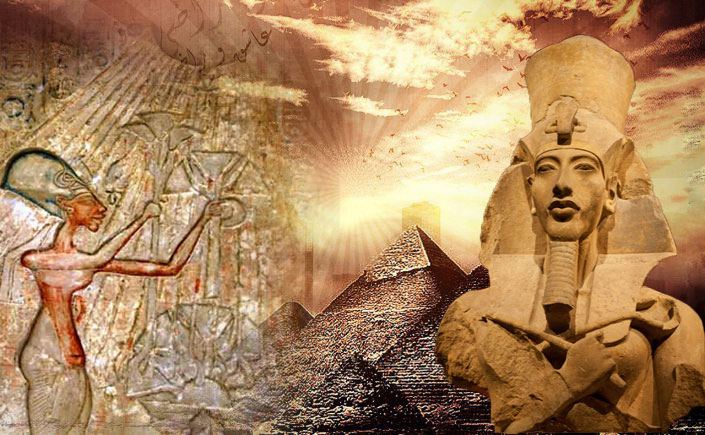 “Pharaoh looked at his friends before him and said: “I have loved you, even as you have loved me. I go now to my Father Aton; my work is finished here in the land of Egypt. . . my heart has found peace, for, at last, the Solar Disc [Aton] is satisfied!” And Pharaoh died!
“Pharaoh looked at his friends before him and said: “I have loved you, even as you have loved me. I go now to my Father Aton; my work is finished here in the land of Egypt. . . my heart has found peace, for, at last, the Solar Disc [Aton] is satisfied!” And Pharaoh died!
Later, gangs of workmen descended on the half empty Akhetaton. Wherever they found the name and features of Akhnaton and Nefretiti in tombs, temples, and private houses, they obliterated them. The Temple of Aton was thrown down and buried.
Akhnaton had written: “There shall be made for me a sepulchre in the Orient Mountain; my burial 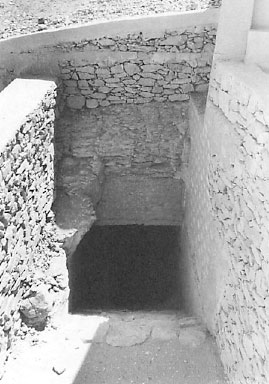 shall be [made] therein in the multitude of jubilees which Aton my Father hath ordained for me; and the burial of the chief wife of the king, Nefretiti, shall be made therein in that multitude of years.. . [and the burial of] the king’s daughter Meritaton shall be made in it in that multitude of years.”
shall be [made] therein in the multitude of jubilees which Aton my Father hath ordained for me; and the burial of the chief wife of the king, Nefretiti, shall be made therein in that multitude of years.. . [and the burial of] the king’s daughter Meritaton shall be made in it in that multitude of years.”
He gave orders that on his death he should be buried “in my sepulchre in the Eastern Mountain.” There is a great wadi which interrupts a line of cliffs and which leads to the solitary Royal Tomb. There is no inscription above the entrance. A sloping passage and a steep flight of steps lead to the burial pit where a sarcophagus once lay. Beyond is a hall with reliefs showing the royal family worshipping the Aton. Opening from the top of the stairs are smaller tomb chambers which were made for Princess Maketaton, the first of the seven daughters to die.
Historians believe that the body found in the so-called Tomb of Queen Tiyi in the Royal Valley at Thebes was that of Akhnaton. From inscriptional and physiological evidence it can be established that this body, which is that of a man of not more than thirty, is the body of Smenkhkare.
No traces of the bodies of the royal couple (Nefretiti and Akhnaton) have ever been found. However, the corpse of a man which had been burned some time after mummification was discovered when the Royal Tomb was excavated. But this corpse was that of Sinuhe (Setymeramun), which had been deposited in the then empty Royal Tomb and later burned. The Amun priests burned the body of Akhnaton because they believed that once the mummy was destroyed all hope of survival by the royal owner vanished. Akhnaton’s ashes were then strewed over the Nile, and the material substance of he who came to serve Egypt returned to her bosom from whence it came.
 With Akhnaton dead, his co-regent Smenkhkare was now Pharaoh. But he and his wife, Meritaton, were fighting a losing mental battle with the Amun priesthood. With Akhnaton finally out of their way, they became drunk with power. They murdered nearly all the prominent Atonists. But they did not touch Ay and Maya. These two men were needed in Egypt for the secret knowledge they possessed, and the victorious priests were certain that they would both now follow Amun, since this false god was once again on the throne of the Egyptian pantheon of gods.
With Akhnaton dead, his co-regent Smenkhkare was now Pharaoh. But he and his wife, Meritaton, were fighting a losing mental battle with the Amun priesthood. With Akhnaton finally out of their way, they became drunk with power. They murdered nearly all the prominent Atonists. But they did not touch Ay and Maya. These two men were needed in Egypt for the secret knowledge they possessed, and the victorious priests were certain that they would both now follow Amun, since this false god was once again on the throne of the Egyptian pantheon of gods.
In order to save the knowledge that had been gathered during Akhnaton’s lifetime, the small band of devoted Atonists decided to work in secret and in hidden chambers. Maya, as royal treasurer, possessed the secret of the Great Pyramid and Sphinx record chambers. If the Amun faction killed him, the secret would perish with him. This would never do, since they desired this knowledge for the depleted treasure houses of Amun. If they let him live, they hoped to eventually obtain the secret from him. His death would defeat them, but his life might serve them if they were patient!
Nefretiti stayed in her palace of retirement with young Tutankhaton and Ankhsenpaaton. Outside were the crowds, always anxious to plunder, whether it was a temple of Aton or one to Amun. But Nefretiti and her palace were not molested; no one of the royal blood would be openly murdered if they didn’t interfere with the plans of Amunism.
Akhnaton had died in 1361 B.C. at the age of forty-seven. Smenkhkare ascended the throne and ruled only nine months, until 1360 B.C.
The young son of Maya and Ilipaaton (Ilipaamun) was Ra, and he was in Thebes with Smenkhkare and Meritaton. The two young rulers had been entertained at a royal banquet and the priests poisoned them. Their secret planning with Nefretiti had been discovered, and the Amun priests knew that they could never use Smenkhkare as a Pharaoh who would serve Amun. So they decided to do away with him. However, something went wrong with the assassination attempt, and the King and Queen, taking Ra with them, went from the banquet hall to their chariot. Although poison had been given to them, it had not taken effect as soon as was hoped.
Although it was a long journey, they rode like the wind from Thebes towards Akhetaton. On the way they were ambushed and were clubbed to death, along with the young Ra.
Their bodies were left on the desert for beasts to devour, but were found by messengers of Nefretiti and were subsequently mummified, although the extremely mangled condition of Ra’s body almost prevented mummification. Meritaton’s remains were placed in the chamber prepared for her in her father’s tomb.
Smenkhkare was buried in an insignificant tomb in the Royal Valley at Thebes, along with a few objects belonging to Queen Tiyi, and his body was therefore well hidden.
Horemheb and the priesthood from Thebes paid a visit to the dead city of Akhetaton and Nefretiti.  They demanded that young Tutankhaton (“The Life of the Aton is Beautiful“) change his name to Tutankhamun (“The Life of Amun is Beautiful“). Nefretiti knew that the young Pharaoh would be a puppet in the hands of the triumphant priests of Amun. But she knew too that he would fulfil an important mission as Pharaoh, a mission that the evil priests would never suspect. You see, Nefretiti knew that Tutankhaton was a “sensitive” or “psychic.” Instructions could be channelled through him to the surviving Atonists for the work they had to complete quickly before they were all eliminated. It was only a matter of time, that they knew, but a short time was all that they needed to see to it that certain records were made safe and secure in the SECRET PLACES OF THE LION!
They demanded that young Tutankhaton (“The Life of the Aton is Beautiful“) change his name to Tutankhamun (“The Life of Amun is Beautiful“). Nefretiti knew that the young Pharaoh would be a puppet in the hands of the triumphant priests of Amun. But she knew too that he would fulfil an important mission as Pharaoh, a mission that the evil priests would never suspect. You see, Nefretiti knew that Tutankhaton was a “sensitive” or “psychic.” Instructions could be channelled through him to the surviving Atonists for the work they had to complete quickly before they were all eliminated. It was only a matter of time, that they knew, but a short time was all that they needed to see to it that certain records were made safe and secure in the SECRET PLACES OF THE LION!
So the young heir to Egypt’s throne became Tutankhamun and Ankhsenpaaton became Ankhsenamun. They were taken to Thebes and the double crown which had been so rudely torn from the heads of two recent rulers was placed on the young head of “Ratut” (Tutankhamun).
The priests still had to wait a little time for complete vengeance. The new Pharaoh was closely associated with the Aton heresy, and while he lived the memory of Akhnaton would not be openly scorned. Too many Egyptians still loved Akhnaton, and if the priests eliminated all the members of the House of Amunhotep it would cause civil war in Egypt, and that would, of course, destroy their new-found power also. They hated the royal family, but they hated anarchy more.
This period was an ugly struggle between powerful interests of Amunism and courtiers who used the royal children as pawns in their game of power. The young couple pretended, on the surface, to fall in with the new faction, but continued secretly as Atonists.
At this point Nefretiti disappears from history. In fact, she did disappear, for she left Egypt and went to a Mystery School in Tibet! Her fabulous beauty and great wealth never turned her head from the Work. She reported to the Masters and Adepts in India, Tibet, and even at Lake Titicaca, Peru, on the workings of Atonism and just how far the Divine Experiment had succeeded in Egypt.
 Some day clay tablets will be discovered in the Mystery Schools, and these will prove to have been written by Nefretiti herself! But they were not brought to these areas from Egypt. If scientists ever examine the clay used in these tablets microscopically, they will find that the clay comes from the area in which the tablets were discovered, and not from Egypt!—definite proof that Nefretiti was actually a visitor to these places! Imagine! A history of Egypt and the world’s first experiment in the Greater Light—preserved in Tibet!
Some day clay tablets will be discovered in the Mystery Schools, and these will prove to have been written by Nefretiti herself! But they were not brought to these areas from Egypt. If scientists ever examine the clay used in these tablets microscopically, they will find that the clay comes from the area in which the tablets were discovered, and not from Egypt!—definite proof that Nefretiti was actually a visitor to these places! Imagine! A history of Egypt and the world’s first experiment in the Greater Light—preserved in Tibet!
These records will establish very important points. There is confusion in ancient dating today because the Amun priesthood deliberately changed dates on some monuments in order to destroy the logical occurrences of Akhnaton’s reign. They wanted to be certain that Aton never had another Dawn!
Negative forces wanted to discourage future researchers so that little could be learned from the labours of Akhnaton. The job of the surviving Atonists, on the other hand, was to preserve the records for future man. Therefore Nefretiti placed the records in Tibet, India, and South America. Others placed the records in the very earth itself—the Truth had to remain!
Wherever Nefretiti journeyed, the outstretched arms of the Aton protected her: “The heiress, great in favour, lady of grace, sweet of love, Mistress of the South and North, fair of face, gay with the two plumes, beloved of the living Aton, the Chief Wife of the King, whom he loves, lady of the Two Lands, great of love, Nefretiti, living for ever and ever…”
Maya and Ilipaamun (she had changed her original name to Ilipaaton—”Beloved Child of Aton”—during the reign of Akhnaton, and was now forced by new convention to change it back again) maintained a house at Thebes where they could be near Pharaoh. The old house of Maya at Akhetaton was practically abandoned except for certain meetings that were held there.
To Maya’s house came the former close friends of Akhnaton, including his brother, the High Priest of Aton (later, the Emperor Justinian), and information from higher planes came to the little group of workers through Tutankhamun! Amunhotep III spoke through his youngest son as the latter was in a deep trance! Sitamun was never a channel in the sense she wanted to be, but she gave the world a son who was very much a medium for certain instructions that were desperately needed at this time!
At this time, two young men of a dark-skinned race were summoned by Amenophis (Iemhotep of another lifetime) to come to Egypt and serve Pharaoh Tutankhamun as bodyguards. At least, that was the apparent outward reason. But the real meaning behind their coming can be found in the fact that these youths were adepts of mental science. They were descended from an ancient, wise race  that existed in Africa when Atlantis was in its prime. These strange people had not developed a very high culture from a materialistic point of view, but their mental development was astounding! They could stop armies by powerful thought-waves and mental vibrations!
that existed in Africa when Atlantis was in its prime. These strange people had not developed a very high culture from a materialistic point of view, but their mental development was astounding! They could stop armies by powerful thought-waves and mental vibrations!
The two young men, who were identical twin brothers, were the sons of a great White Magician, and were brought to Egypt for two purposes: first of all, they were to protect the Pharaoh so that no harm would come to him; secondly, and more important, they were to surround certain tombs, temples, and secret chambers with a peculiar vibrational thought-pattern that would endure through the ages and keep out all those of a frequency which opposed the area of the secreted records.
It should be mentioned here that immediately following the death of Akhnaton, the Lesser Exodus of the Israelites began. Because of political confusion and civil war, the Egyptians were not concerned with the Israelites. They didn’t care whether they stayed or went. So, many left Egypt, along with some Egyptians who wished to escape the wrath of Amun, and thus the Exodus began. It continued over many years, however, with small groups and successive waves leaving at various opportune times. But there was a Greater Exodus to come, and we will speak of that when we come to Revelation.
Now Maya felt his position was secure, since he alone in the Two Lands of Egypt held the secret of the entrance to the treasure chambers under the Great Pyramid, the Sphinx, and Hatshepsut’s Temple of Splendours. When the Pharaohs were taken to these chambers, even they were blindfolded! No one was to know the secret, except the royal treasurer!
Several thousand years before the Eighteenth Dynasty of Egypt, Maya had been the Ruling Prince of Lemuria, Ilipaamun had been “Lady of the Sun,” and Tutankhamun had been “Merk.” Here we find the same individuals working together once again.
Tutankhamun serves as a messenger once again as he delivers the message from higher planes. Maya leads his people again; and Ilipaamun serves as historian and record-keeper. At the house of Maya many, many records were written by all those gathered on clay tablets and papyri.
These records have not yet come to the attention of archaeological investigation, but they will soon. They speak of the coming of Space People to Egypt, of the early Pharaohs as men of other worlds (planets) who incarnated on earth to bring certain Light to mankind, and of the true purpose for Akhnaton’s life and labour. Even records brought from other inhabited planets are there!
Shortly after the work was being conducted in Maya’s residence, Princess Meriten, daughter of Amunhotep III and Sitamun, was murdered by robbers at Akhetaton. She was at the studio of her lover, the great artist Thotmes, the oldest son of Cato. Thotmes was the sculptor who made the world-famous painted limestone bust of Queen Nefretiti, the brown sandstone head of the same gracious lady, several heads and masks of Akhnaton himself, and other splendid works.
Bek and Auta, the brothers of Thotmes, had been murdered in Thebes the night Pharaoh Akhnaton died in Akhetaton. And now the two lovers, Thotmes and Meriten, were hurriedly burying the famous bust of Nefretiti, which was eventually discovered centuries later by the German expedition during excavations at Tel-el-Amarna. They were surprised by vandals and killed.
 Maya had made a visit to the secret Pyramidal subterranean chambers and brought an ancient vril stick to Tutankhamun. This was further protection for the boy king. Existing statues of him show him holding strange “rods.”
Maya had made a visit to the secret Pyramidal subterranean chambers and brought an ancient vril stick to Tutankhamun. This was further protection for the boy king. Existing statues of him show him holding strange “rods.”
Also at that time, Maya brought out two of the crystal balls originally brought by visitors from outer space during the building of the Great Pyramid. These objects were not solid crystal, but were made up of nine sections, fitted and locked together to form a globe or ball. As light passed though them, it was changed in a most unusual manner and the past and future could be partially ascertained in the ball. However, a certain amount of mental control was needed by the user during the period of concentration using the crystal ball.
These balls were used telepathically as a screen and for time-scanners. Their existence was not known by the Amun priests. However, it wouldn’t have done them any good, because these objects could never be used for a negative purpose! Several of these crystal balls are still under the Sphinx! Nostradamus had one of them, and deduced many things from its use!
The orb and sceptre of later rulers had their origin in the crystal ball and vril stick—ancient symbols of power!
Tantahpe was the daughter of Maya and Ilipaamun. She had been dedicated to Isis as a child and was now a priestess of Isis. However, as stated before, the cult had undergone drastic changes whereby Isis was not worshipped as a goddess but was venerated as the symbol of female purity and innocence. The virgins dedicated in her former temple were similar to the later Roman vestal virgins and served in the temple of Aton at Akhetaton.
Now that Amun was reigning supreme again, Isis was installed once again as a great goddess. Tantahpe had to decide whether or not to stay with Isis in her new role under Amun or stay with Aton. She would not be held in disgrace in the revamped Isis cult, since virginity was not a requirement for the women who served there with the sistrum.
When her younger brother, Ra, had perished with Pharaoh Smenkhkare in the royal chariot, she decided she would soon leave the service of Isis and go to her lover, make him her husband and work with him. He was an Atonist who worked closely with her father, Maya.
Rahotep, son of Cato, had been Solomon and Queen Tiyi had been Hatshepsut. Therefore there was a  great attraction between these two and the young artist made many sketches of the great queen when he was at her palace. She assisted him in every way she could in the furtherance of his inherent artistic talent. Rahotep lived in the house of Maya, and Maya was like a second father to him. Since this youth had the same name as the murdered son Ra, he was welcome to fill his place and memory. So again we find David (Maya) and Solomon (Rahotep) working together!
great attraction between these two and the young artist made many sketches of the great queen when he was at her palace. She assisted him in every way she could in the furtherance of his inherent artistic talent. Rahotep lived in the house of Maya, and Maya was like a second father to him. Since this youth had the same name as the murdered son Ra, he was welcome to fill his place and memory. So again we find David (Maya) and Solomon (Rahotep) working together!
Tutankhamun reigned for nine years, and his conduct during his brief reign had not been such as altogether to please the priesthood of Amun, for his name, like that of Akhnaton, was later omitted from the king-lists, and Horemheb erased his name on every possible opportunity, which shows that the youth struggled against the malignity of the priests.
Tutankhamun assisted in writing and depositing the Aton records; then when his purpose in that lifetime was fulfilled it was ordained that he return to his Father Aton.”
Excerpt from Secret Places of The Lion by George Hunt Williamson
See Part I here See Part II here See Part III here See Part IV here
Posted in True History of Manwith comments disabled.


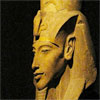
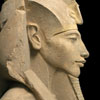
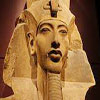

[…] Part I here See Part II here See Part III here See Part IV […]